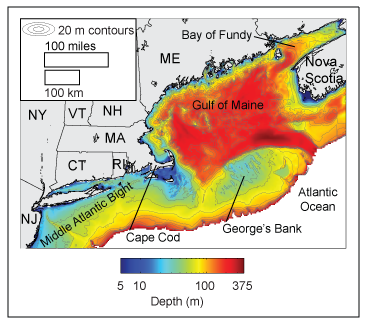
|
 |
| Figure 2. Map showing the bathymetry of the Gulf of Maine and regional physiographic features. Characterizations of bottom shear stress and sea floor mobility in this database extend offshore to approximately the 120-m isobath. |
The Gulf of Maine region is the semi-enclosed basin separated from the Atlantic Ocean to the south by George's Bank, and extends from Cape Cod to Nova Scotia. (fig. 2).
Spatially and temporally resolved estimates of bottom shear stress are calculated for seasonal and annual time periods. Seasons are defined as Winter (December-February), Spring (March-May), Summer (June-August), and Fall (September-November).
Specifications for stress and mobility time series:
- Spatial Resolution: Approximately 3.5 km.
- Time Period: May 2010, to May 2011.
- Temporal Resolution: Hourly.
Data sets used to compute the bottom stress and sediment mobility time series:
- Currents: The Northeast Coastal Ocean Forecast System (NECOFS) for the Gulf of Maine, which uses the Finite Volume Community Ocean Model (FVCOM). The FVCOM domain includes the Gulf of Maine, George's Bank, and portions of the Middle Atlantic Bight. Developed at the University of Massachusetts at Dartmouth (http://fvcom.smast.umassd.edu/research_projects/NECOFS/).
Contact: Model run by Dr. Changsheng Chen, Marine Ecosystem Dynamics Modeling Lab (http://omgrhe.meas.ncsu.edu/Group/).
- Waves: Simulating WAves Nearshore (SWAN) model applied to the western North Atlantic.
Contact: Model run by Dr. P. Soupy Dalyander, U.S. Geological Survey St. Petersburg Coastal and Marine Science Center
- Sediment Texture Data: USGS East-Coast Sediment Texture database (Poppe and others, 2005).
Complete details on the procedure used to create the data files may be found in the associated metadata (links in Table 1).
Table 1. Statistics of sea floor wave-current stress and sediment mobility in Arc polygon and point shapefile format for the Gulf of Maine from model output. Stress statistics are determined for the entire model grid, whereas mobility statistics are determined only at locations where sediment texture data are available. See metadata files for details of the calculations. Click on zip file to download.
Median of Bottom Shear Stress
Preview (Yearly Value) |
The value of bottom shear stress exceeded 50% of the time. |
Shapefile - polygon
View Metadata |
zip |
Interpercentile Range of Bottom Shear Stress
Preview (Yearly Value) |
Half the difference between the 84th and 16th percentile. A measure of variability, equivalent to the standard deviation in a normal distribution. |
Shapefile - polygon
View Metadata |
zip |
95th Percentile of Bottom Shear Stress
Preview (Yearly Value) |
Value of bottom shear stress exceeded 5% of the time. A measure of the largest stresses. |
Shapefile - polygon
View Metadata |
zip |
Bed Mobility Percentage
Preview (Yearly Value) |
Percentage of time the critical stress is exceeded (determined for locations with sediment texture data). A measure of the extent of bed mobility. |
Shapefile - point
View Metadata |
zip |
Bed Mobility Recurrence Interval
Preview (Yearly Value) |
Time between mobility events (determined for locations with sediment texture data). A measure of the of frequency of mobility events. |
Shapefile - point
View Metadata |
zip |
|